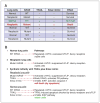Back to the future: mechanism-based, mutation-specific combination chemoprevention with a synthetic lethality approach
- PMID: 21543341
- PMCID: PMC3574813
- DOI: 10.1158/1940-6207.CAPR-11-0162
Back to the future: mechanism-based, mutation-specific combination chemoprevention with a synthetic lethality approach
Abstract
There is an increasing recognition that the mutations accompanying carcinogenesis may provide a window of therapeutic advantage designated synthetic lethality, an example of which is reported in this issue of the journal by Huang and colleagues (beginning on page 666). First discovered and studied in yeast, synthetic lethality has basic principles that have encouraged its development for treatment and now prevention in animal models of human cancer, especially malignancies refractory to standard approaches. The pros and cons of this approach and challenges in implementing it clinically are discussed.
Conflict of interest statement
F.L. Meyskens is cofounder of Cancer Prevention Pharmaceuticals, Tucson, Arizona, and holds a substantial equity interest; he is also Chief Medical Advisor for the company, but takes no remuneration. E.W. Gerner has an ownership interest in Cancer Prevention Pharmaceuticals.
Figures

Similar articles
-
An intermittent approach for cancer chemoprevention.Nat Rev Cancer. 2011 Nov 10;11(12):879-85. doi: 10.1038/nrc3167. Nat Rev Cancer. 2011. PMID: 22071977 Review.
-
Lung-cancer chemoprevention by induction of synthetic lethality in mutant KRAS premalignant cells in vitro and in vivo.Cancer Prev Res (Phila). 2011 May;4(5):666-73. doi: 10.1158/1940-6207.CAPR-10-0235. Cancer Prev Res (Phila). 2011. PMID: 21543344
-
Applying synthetic lethality for the selective targeting of cancer.N Engl J Med. 2014 Oct 30;371(18):1725-35. doi: 10.1056/NEJMra1407390. N Engl J Med. 2014. PMID: 25354106 Review. No abstract available.
-
Novel multiple, monoallelic KRAS mutations at codon 12 and 13.Int J Cancer. 2009 Dec 1;125(11):2744-5. doi: 10.1002/ijc.24635. Int J Cancer. 2009. PMID: 19521964 No abstract available.
-
[Basic principles for the prevention, diagnosis and therapy of lung cancer].Magy Onkol. 2012 May;56(2):114-32. Magy Onkol. 2012. PMID: 22724157 Hungarian. No abstract available.
Cited by
-
Gut microbes, diet, and cancer.Cancer Treat Res. 2014;159:377-99. doi: 10.1007/978-3-642-38007-5_22. Cancer Treat Res. 2014. PMID: 24114492 Free PMC article. Review.
-
The Overexpression of FEN1 and RAD54B May Act as Independent Prognostic Factors of Lung Adenocarcinoma.PLoS One. 2015 Oct 2;10(10):e0139435. doi: 10.1371/journal.pone.0139435. eCollection 2015. PLoS One. 2015. PMID: 26431531 Free PMC article.
-
Short-term Intervention to Revert Premalignant Lesions as Strategy to Prevent Gastrointestinal Cancers.J Cancer Prev. 2013 Dec;18(4):289-97. doi: 10.15430/jcp.2013.18.4.289. J Cancer Prev. 2013. PMID: 25337558 Free PMC article. Review.
-
Mitigating the risk of radiation-induced cancers: limitations and paradigms in drug development.J Radiol Prot. 2014 Jun;34(2):R25-52. doi: 10.1088/0952-4746/34/2/R25. Epub 2014 Apr 14. J Radiol Prot. 2014. PMID: 24727460 Free PMC article. Review.
-
An intermittent approach for cancer chemoprevention.Nat Rev Cancer. 2011 Nov 10;11(12):879-85. doi: 10.1038/nrc3167. Nat Rev Cancer. 2011. PMID: 22071977 Review.
References
-
- Sporn MB. Combination chemoprevention of cancer. Nature. 1980;287:107–8. - PubMed
-
- Kinzler KW, Vogelstein B. Lessons from hereditary colorectal cancer. Cell. 1996;87:159–70. - PubMed
-
- Druker BJ, Talpaz M, Resta DJ, Peng B, Buchdunger E, Ford JM, et al. Efficacy and safety of a specific inhibitor of the BCR-ABL tyrosine kinase in chronic myeloid leukemia. N Engl J Med. 2001;344:1031–7. - PubMed
-
- Benson JD, Chen YN, Cornell-Kennon SA, Dorsch M, Kim S, Leszczyniecka M, et al. Validating cancer drug targets. Nature. 2006;441:451–6. - PubMed
MeSH terms
Substances
Grants and funding
LinkOut - more resources
Full Text Sources
Medical
Miscellaneous

